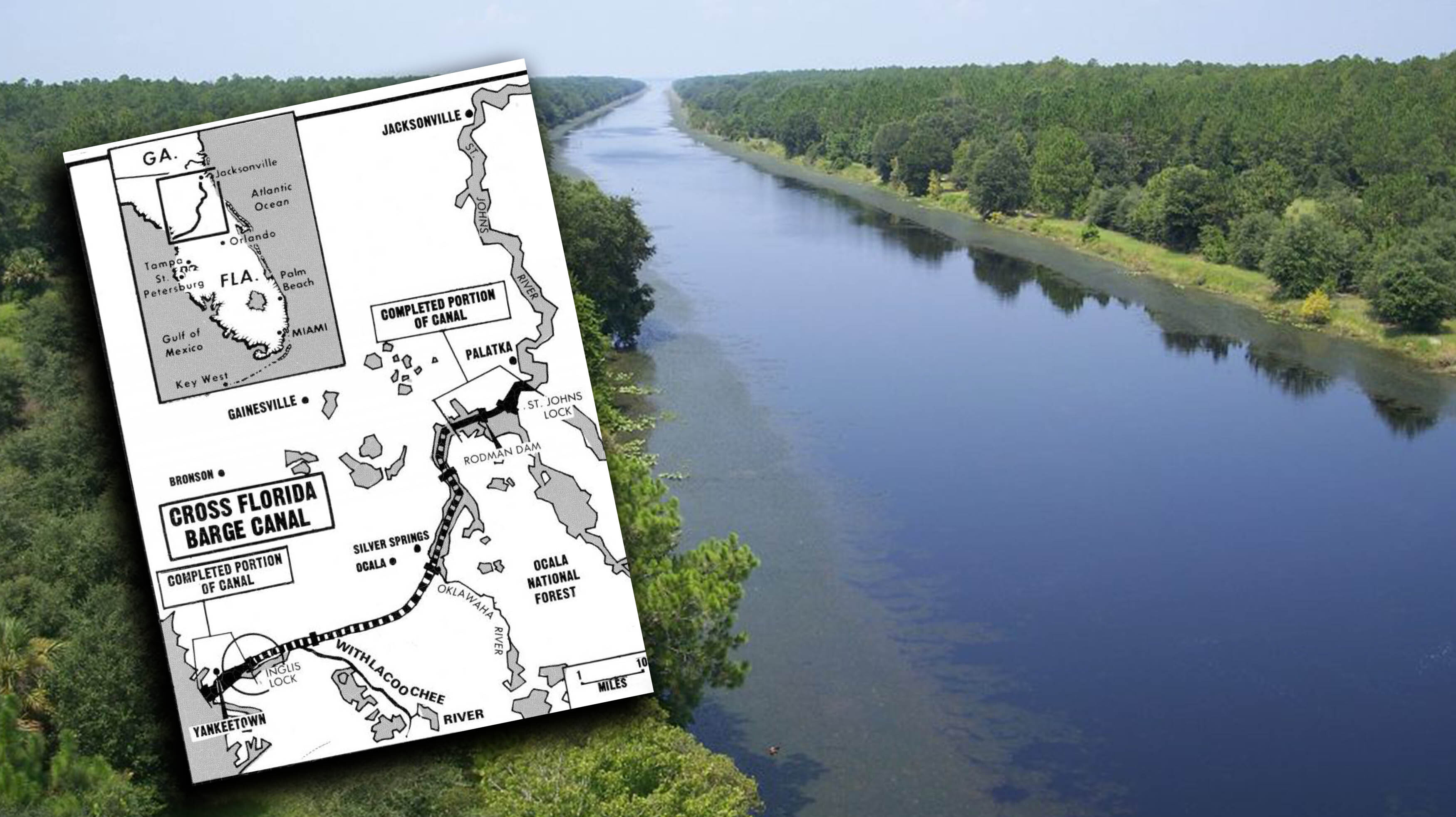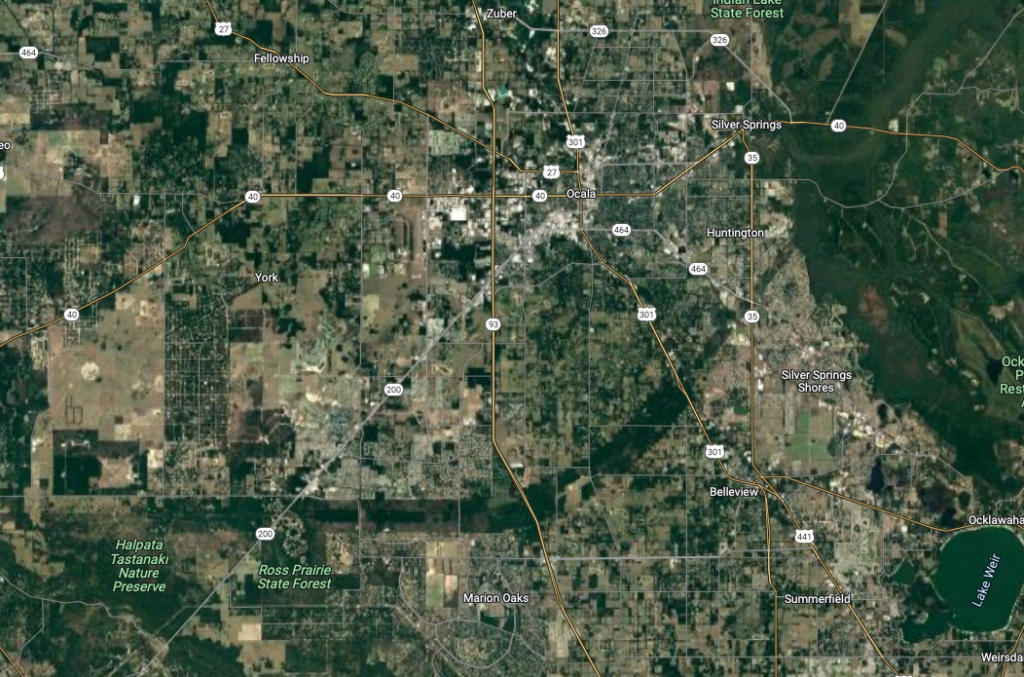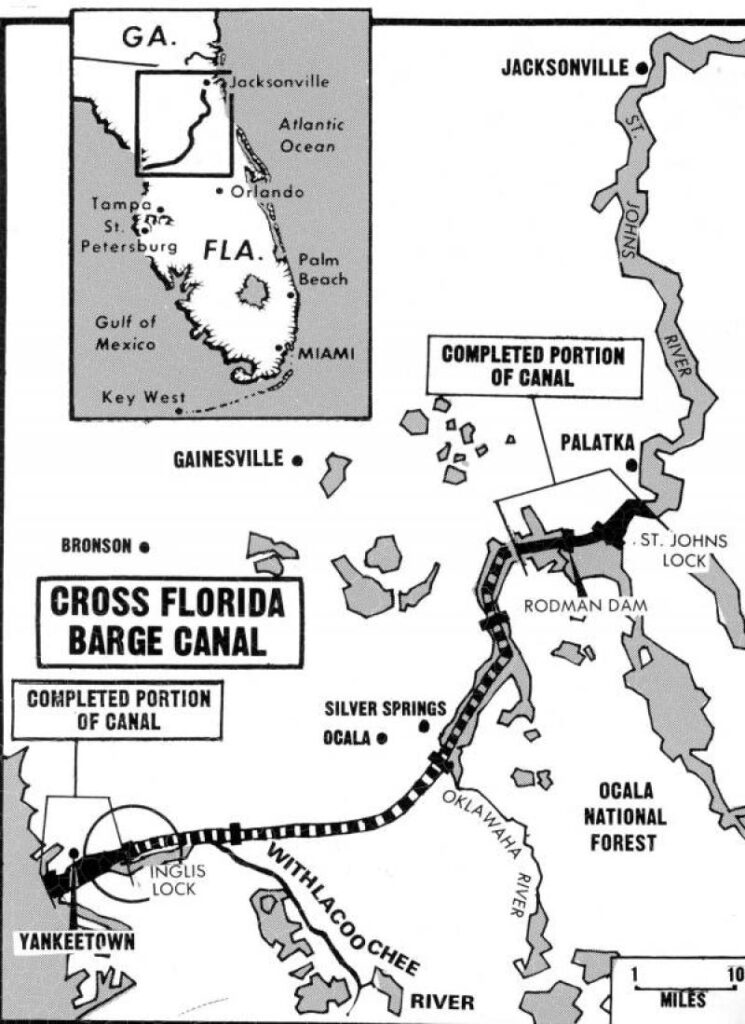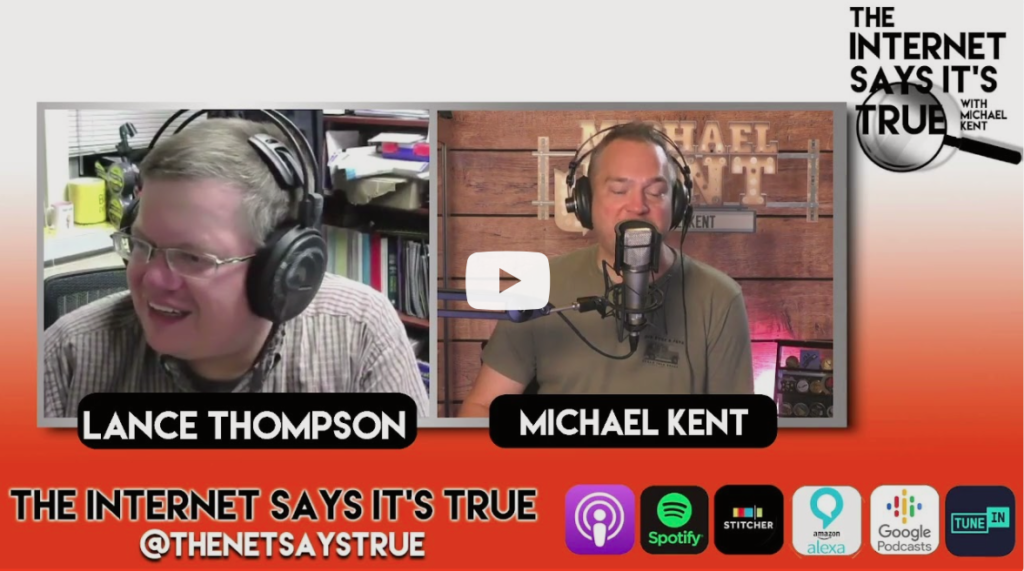The Cross Florida Barge Canal
For more than 100 years, there were plans to cut a canal through the middle of the Florida Peninsula. It would have allowed a huge shipping lane from the Gulf to the Atlantic Ocean. But despite a dozen starts and stops, it was never completed. In this episode, we talk about the canal, its demise, its remnants and the important conservation effort that ended it. Then we chat with Lance Thompson for the quick quiz!

If you look just South of Ocala, Florida, there’s this large rectangular swath of land that looks different than the land around it. On the map, it appears like a green sort of hockey stick. I was curious, so I started googling and was completely shocked with what I found.
What I was looking at were the remnants of a huge national project: The Florida Cross Barge Canal.

This was a plan to literally cut a canal all the way across Florida, essentially making most of the peninsula into an island! It would allow ship traffic to leave straight from the Gulf of Mexico, across Florida and into the Atlantic Ocean. It was an ancient idea.
The first time anyone thought of doing such a thing was all the way back in 1567. The King of Spain, Philip II, wanted a safer route for Spanish treasure ships that were being constantly plundered by pirates. American ships were being pirated too, and were exposed to all kinds of foul weather on the Atlantic sailing around Florida, so War Secretary John C. Calhoun and Daniel Webster proposed a similar plan in 1818 to build a canal through the state. But in 1861, a cross-state railroad helped to move cargo across the state safely by train. And between 1829 and 1911, a total of six studies had all concluded that building a canal across Florida would be too expensive and too difficult to be worth the cost.
Even so, politicians in Florida wanted the canal. They wanted an easier route to ship goods like Timber, cotton and eventually oil between the Gulf and the Atlantic. They lobbied the government and eventually developed the Canal Authority of the State of Florida to direct the effort. Finally – in 1935, President Franklin Roosevelt authorized $5 million in Federal money for the project, although it was estimated at the time that it would cost $143 million to complete. It was part of his New Deal program. The whole point of the program was to invest in construction and infrastructure projects just like this. They built 9 Florida State Parks with the New Deal money and began the work on clearing land for the canal. The construction began, but was soon halted. Arthur Vandenberg was a Senator from Michigan who complained that Congress had never authorized the use of Federal money for this canal. In addition to that, there was worry that the canal was disrupting Florida’s aquifer and waterway ecosystems, so the whole project ground to a halt. By that point, 5,000 acres of forest land had already been cleared. It was 3 years since construction had started and the funds had already been used up.
It was another 6 years before the canal project was revisited. This time because of the War. World War II was threatening the US as German U-boats were threatening the Florida Coast and American shipping lanes. Congress reauthorized the canal project as a way to help protect the coast because naval ships could navigate between the Gulf and the Ocean more quickly. $93 million was authorized and the new plans included a system of locks and dams to help protect local waterways. After World War II was the Cold War and the Cuban Missile crisis and a canal would keep ships from having to loop down around the state coming dangerously close to Cuba. The motivation of National Defense was finally a strong enough incentive to overcome the environmental concerns that had stopped progress of the canal in the first place.
Here’s what the canal was meant to look like. If you’ve driven through Jacksonville, Florida, you’ve seen that the city has a major river running through it. That’s the St. Johns River, and it would be the entry point from the canal into the Atlantic Ocean. If you follow the St. Johns River all the way South to the city of Palatka, that’s where construction of a new waterway heading West would begin. It would cut through to the Ocklawaha River, then down around the bottom of Ocala, and then to Withlacoochie Bay around Yankeetown – a total of 110 miles including three dams and five locks. It would be 150 ft wide and 12 feet deep.

With the money reauthorized and both World War II and the Cold War as motivations, planning resumed in 1963 with support from JFK and in 1964, construction once again started on the canal – this time it was FDR himself who was on hand at the ceremony to set off the first explosions. It was scheduled to be completed by 1971. Construction began – the section connecting the St. Johns River to the Ocklawaha, and a small section extending a few miles from the Gulf of Mexico. But that was it. Just 28% of the canal was built.
I mentioned earlier that you can see a “hockey stick” shaped area under Ocala Florida on a satellite map. It’s clearly manmade, as the green area appears to have perfectly parallel sides and distinct angles.
What you’re looking at is the original path of the first attempt at the canal – when land was initially cleared back in the 1930s. And there are some really ugly parts to the story. For instance, at one point a labor organizer named George Timmerman came to the work site. In August of 1935, 8,000 workers had shown up to Ocala to start clearing land for the canal. To make sure that those workers were being treated humanely and fairly, Timmerman had traveled to Ocala. He was found the next day tied to a tree with his lips sewn shut. And that’s just one story. Another is the sad story of the town of Santos. Santos, Florida was an African American community six miles south of Ocala. The entire community was destroyed to build Camp Roosevelt – the camp created to house all of the canal’s laborers. Hardly any record of this original settlement remains. The path that was dug was a sea-level cut into the earth, with 40 foot berms up to land. As I stated earlier, the project was abandoned when met with a combination of environmental concerns and lack of funds.
But this new revitalized effort in the 1960s really had some steam. Things were finally happening with the canal. And this is where we meet a woman named Marjorie Harris Carr. She was an active member of the Audubon Society, and in 1962, invited a couple officials to give a talk about the environmental impact of the canal. Both state and federal authorities presented a ton of information about the likely negative effects of the canal on Florida’s ecosystem and, according to Carr, “The audience that had come to the meeting with a completely neutral attitude toward the canal project went away that evening disturbed, uneasy, and determined to find out more about the probable effects of the barge canal on the Florida environment.” They learned of the many plants and animals that would be affected, like the Florida Manatees that would certainly be disturbed by the canal. Fifteen endangered species, like the Red Cockaded Woodpecker, would be severely affected. Even species like spring-dwelling mussels and shrimp would be impacted by the loss of ground water in the porous Florida limestone. Finally – the humans in Florida would be affected. They rely on the aquifer and local water tables to provide water to the citizens and with this new canal, the ground water could be exposed to dangerous pollutants at a record pace.
That Audubon Society presentation was just the beginning. By 1969, Carr and other concerned citizens founded the Florida Defenders of the Environment, a group determined to oppose the completion of the canal. They were joined by hydrologists, geologists, economists, zoologists and other scientists who presented well-researched data – so much so that they were actually taken seriously. Newspaper articles, editorials, books and documentaries were vocal and critical of the canal, many of them citing research that had been provided by the Florida Defenders of the Environment. The notoriety of their cause really gained a ton of support within Florida and triggered a reassessment of the financial advantages of the canal. It turned out that most of the financial advantages of the canal would be going to areas outside of Florida, like the Texas oil industry. The main body of work Marjorie Harris Carr and the Florida Defenders of the Environment used to prove their case was a detailed scientific paper titled, “Environmental Impact of the Cross Florida Barge Canal With Special Emphasis on the Ocklawaha River System.” In 1970, the FDE along with another group, the Environmental Defense Fund, sued to stop construction of the canal and a Federal judge issued an injunction to halt construction. Construction stopped in January of 1971. Three days later, President Nixon canceled the project. A total of $74 Million dollars had been spent on the project.
While construction never began again, the project was still officially authorized. Carr spoke before Congress to push for deauthorization, which was finally accomplished in 1990. She spent the rest of her life working to restore the environment which had been seriously disturbed from the construction around the Ockalwaha River basin. One of the reasons that this story is so interesting to me is this was really the first time a huge federal project like this had been defeated because of environmental concerns.
Today, much of the area that was destroyed for the canal has been turned into a Greenway to encourage the return of the ecosystem that was displaced. There are hiking trails and bike paths through it and in 1998, a year after Carr’s death, it was named the Marjorie Harris-Carr Cross Florida Greenway.
Review this podcast at https://podcasts.apple.com/us/podcast/the-internet-says-it-s-true/id1530853589
Bonus episodes and content available at http://Patreon.com/MichaelKent
For special discounts and links to our sponsors, visit http://theinternetsaysitstrue.com/deals


